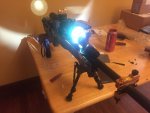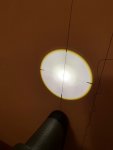I use the flashlight method with all my rifles.
Use a plumb bob hanging from a nail with white paper taped to wall to increase visibility.
Also, you still want a small level to first check that your platform is level, then to ensure the receiver is also level. Of course mucking with stuff during the process you tend to knock out of level so check level throughout the process.
You will also want the reticle to shine as large as possible while remaining crisp on the wall. This allows the greatest "surface area" when aligning the reticle to the plumb bob. Adjusting distance from wall works well.
Once everything is aligned start to tourque down in small increments from screw to screw until snug enough that the scope doesnt move.
Put level on top turrent, it should also be level. Once confirmed, tighten rings rest of the way.
This has always worked very well for me. also like the idea of leveling to my position. Will check that out as well.
ETA: Sort of a crappy pic at a weird angle, but you get the idea. If you have a scope-level just include it in the process. One of my rifles has Steiner T rings with built in level...so you have to make sure to torque them to level during the process.



